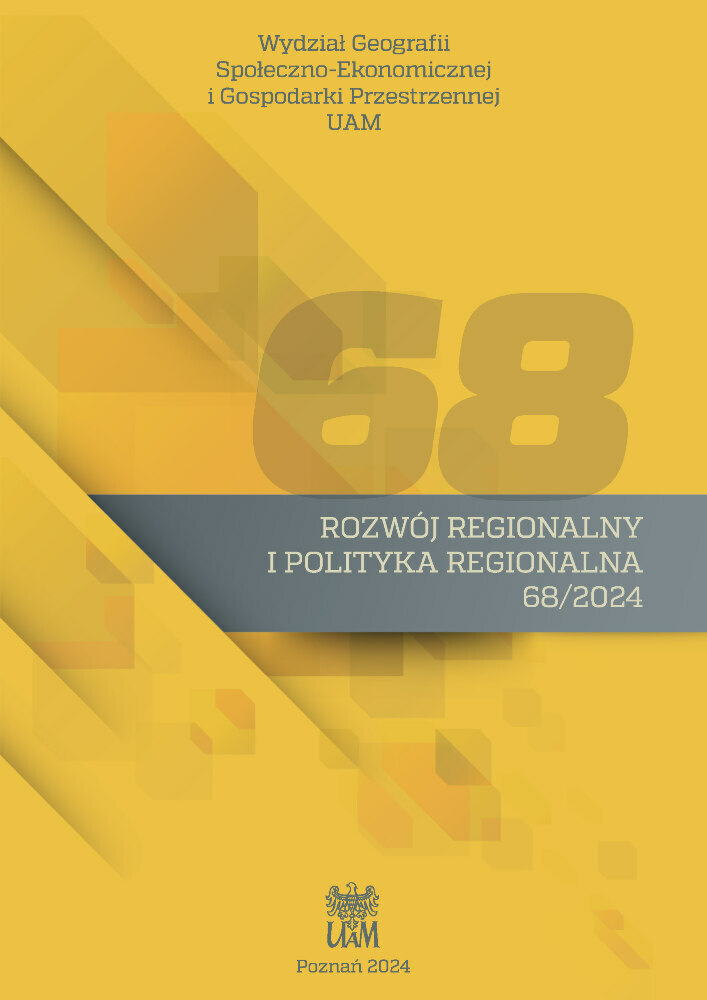Abstrakt
Metropolisation and globalisation have had a significant influence on space and development, both in terms of the physical and social aspects of the environment. Metropolitan areas have become engines of development, centres of economic activity, innovation, and culture, attracting people and businesses from all over the world. However, this concentration of people and activities has also resulted in significant challenges concerning management of their sustainable development. Most of today’s challenges are spread across administrative borders and working at the level of the metropolitan area can help develop innovative solutions that benefit the wider functional urban areas. Many of the problems faced by territories cut across sectors and effective solutions require an integrated approach to managing the development of functional urban areas (FUAs) and cooperation between the various authorities and stakeholders involved. The aim of this study is to evaluate the degree to which an integrated approach to development management is used in the management of metropolitan areas in Slovenia. The research focuses on FUAs of Ljubljana and Maribor. The results show that policy makers understand the need for integrated planning and management on a supralocal level. Local authorities commonly cooperate with each other using legitimate forms of institutionalising inter-municipal cooperation.
Bibliografia
Administrative divisions of Slovenia. 2019 (https://www.best-country.com/en/europe/slovenia/administration).
Bovaird T. 2005. Public governance: balancing stakeholder power in a network society. International Review of Administrative Sciences, 71/2: 217-228. DOI: https://doi.org/10.1177/0020852305053881
Candel J.J.L. 2017. Holy Grail or inflated expectations? The success and failure of integrated policy strategies. Policy Studies, 38/6: 519-552. DOI: https://doi.org/10.1080/01442872.2017.1337090
Danielewicz J. 2013. Zarządzanie obszarami metropolitalnymi wobec globalnych procesów urbanizacji. Wydawnictwo Uniwersytetu Łódzkiego, Łódź. DOI: https://doi.org/10.18778/7525-914-8
Dijkstra L., Poelman H., Veneri P. 2019. The EU-OECD definition of a functional urban area. OECD Regional Development Working Papers, 11. OECD Publishing.
Dijkstra L., Garcilazo E., McCann P. 2013. The economic performance of European cities and city regions: Myths and realities. European Planning Studies, 21/3: 334-354. DOI: https://doi.org/10.1080/09654313.2012.716245
Drobne S., Lamovšek A.Z. 2017. Functional Urban Areas as Instruments of Spatial Development Policy at the Regional Level in the Case of Slovenia. Scientific Papers, 25: 200-215. DOI: https://doi.org/10.31522/p.25.2(54).3
Duranton G. 2008. Cities: Engines of Growth and Prosperity for Developing Countries? World Bank, Washington DC.
Duranton G., Venables A.J. 2018. Place-based Policies for Development. NBER Working Paper, 24562. DOI: https://doi.org/10.3386/w24562
ESPON. 2014. Atlas on European Territorial Structures and Dynamics. ESPON & BBSR.
Feiock C.R. (ed.) 2004. Metropolitan Governance. Conflict, Competition and Cooperation. Georgetown University Press, Washington.
Fritsch M., Wyrwich M. 2021. Is innovation (increasingly) concentrated in large cities? An international comparison. Research Policy, 50(6): 104237. DOI: https://doi.org/10.1016/j.respol.2021.104237
Healey P. 2006. Territory, integration and spatial planning. [In:] M. Tewdwr-Jones, P. Allmendinger (Eds.), Territory, Identity and Spatial Planning, Spatial Governance in a Fragmented Nation. Routledge, London, p. 64-80.
https://portal.cor.europa.eu/divisionpowers/Pages/Slovenia.aspx
https://rralur.si/en/region/development-documents/
https://www.jhmb.si/o-holdingu
https://www.jmss-mb.si/index.php/sl/mnupredstavitev/271-o-nas
https://www.rcero-ljubljana.eu/
https://www.smartcitymaribor.si/si/
Kaczmarek T., Mikuła Ł. 2007. Ustroje terytorialno-administracyjne obszarów metropolitalnych w Europie, Bogucki Wydawnictwo Naukowe, Poznań.
Karta Lipska w sprawie Europejskich Miast Zrównoważonych. 2007.
Knieling J., Kuerschner J. 2011. Territorial cohesion by supra-regional urban-rural partnerships. Exploration of different forms of cooperation between metropolitan cores and peripheral regions, the cases of the city of Amsterdam and the metropolitan region of Hamburg. [In:] Contested Regions: Territorial Politics and Policy. Regional Studies Association, Seaford.
Kübler D., Schenkel W., Leresche J.P. 2003. Bright Lights, Big Cities? Metropolisation, Intergovernmental Relations, and the New Federal Urban Policy in Switzerland. Swiss Political Science Review, 9: 261-282. DOI: https://doi.org/10.1002/j.1662-6370.2003.tb00407.x
Marek M., Müller R. 2019. Metropolitan Regions in the Danube Region. Policy paper. EUSDR Priority Area, 10. Institutional Capacity and Cooperation, Vienna.
Markowski T. 2011. Funkcjonowanie gospodarki przestrzennej – założenia budowy modelu zintegrowanego planowania i zarządzania. Studia KPZK PAN, 134: 25-44.
Markowski T., Turała M. (Ed.) 2015. Planowanie jako instrument zintegrowanego zarządzania w jednostkach samorządu terytorialnego. Katedra Zarządzania Miastem i Regionem Uniwersytetu Łódzkiego, Łódź.
MJU. 2017. Skupne Občinske Uprave. Ljubljana.
MOP. 2004. Spatial Development Strategy of Slovenia. Ministry of the Environment, Spatial Planning and Energy, Ljubljana.
MOP. 2013. Prenova Strategije prostorskega razvoja Slovenije. Ljubljana (http://www.mop.gov.si/si/delovna_podrocja/prostorski_razvoj_na_nacionalni_ravni/).
National Report on Urban Development – HABITAT III. 2016. Ministry of the Environment and Spatial Planning, Ljubljana.
Nelles J. 2021. Alternative Manifestations of Metropolisation: Spatial Dissimilarity and the Tensions between Heuristics and Realities of Metropolisation. Urban Geography, 42/1: 21-36-36. DOI: https://doi.org/10.1080/02723638.2019.1670572
OECD. 2012. Definition of Functional Urban Areas (FUA) for the OECD metropolitan database. Paris.
Promotion of Balanced Regional Development Act. USSR-2. Official Gazette of the Republic of Slovenia, 20/11, 57/12 and 46/16.
RDA LUR. 2019. Sustainable Urban Mobility Plan of the Ljubljana Urban Region. Ljubljana.
RDA LUR. 2022. Regional Innovation Strategy of the Ljubljana Urban Region 2030. Ljubljana.
Resolucija o Strategiji prostorskega razvoja Slovenije 2050 (ReSPR50) 2023. Uradni list Republike Slovenije, Št. 72.
RRA Podravje – Maribor 2022. Regionalni razvojni program Podravja 2021-2027. Maribor.
Ruiz-Tagle J. 2013. A Theory of Socio-spatial Integration: Problems, Policies and Concepts from a US Perspective. International Journal of Urban and Regional Research, 37/2: 388-408. DOI: https://doi.org/10.1111/j.1468-2427.2012.01180.x
Rules on regional development agencies. Official Gazette of the Republic of Slovenia, 3/13, 59/15, 12/17.
Rus P., Nared J., Bojnec Š. 2018. Forms, areas, and spatial characteristics of intermunicipal cooperation in the Ljubljana Urban Region. Acta Geographica Slovenica, 58-2: 47-61. DOI: https://doi.org/10.3986/AGS.4830
SDSS Spatial Development Strategy of Slovenia 2004. Official Gazette of the Republic of Slovenia, 76.
Spatial Management Act (ZUreP-3). 2017.
Strategija razvoja Maribora 2030. 2012. Maribor.
Tosun J., Lang A. 2017. Policy integration: Mapping the different concepts. Policy Studies, 38/6: 553-570. DOI: https://doi.org/10.1080/01442872.2017.1339239
Uradni list Republike Slovenije.
Urban Agenda for the EU. Pact of Amsterdam. 2016.
Vigar G. 2009. Towards an integrated spatial planning? European Planning Studies, 17/11: 1571-1590. DOI: https://doi.org/10.1080/09654310903226499
Vlada R.S. 2016. Strategija razvoja lokalne samouprave v Republiki Sloveniji do leta 2020. Ljubljana (http://www.mju.gov.si/fileadmin/mju.gov.si/pageuploads/SOJ/2016/Strategija_LS_2020/12_SRLS_1692016_vlada.pdf).
Zakon o lokalni samoupravi. 2007. Uradni list Republike Slovenije, 94. Ljubljana.
Licencja
Prawa autorskie (c) 2024 Justyna Danielewicz

Utwór dostępny jest na licencji Creative Commons Uznanie autorstwa 4.0 Międzynarodowe.

